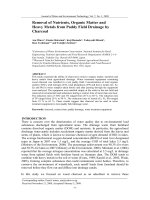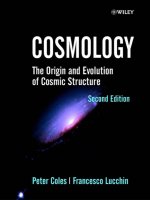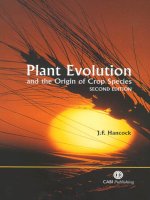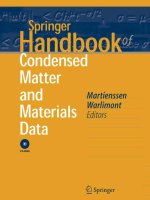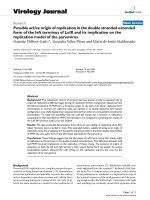Origin of matter and evolution of galaxies m terasawa, s kubono, t kishida (world scientific, 2005)
Bạn đang xem bản rút gọn của tài liệu. Xem và tải ngay bản đầy đủ của tài liệu tại đây (24.65 MB, 603 trang )
O r i g i n of M a t t e r
E v o l u t i o n of Galaxies
2
0
0
3
This page intentionally left blank
Editors
M. Terasawa
CNS, University of Tokyo,Japan
5.Kubono
CNS, University of Tokyo, Japan
T. Kishida
RIKEN, Japan
T. Kajino
National Astronomical Observatory, Japan
T. Motobayashi
RIKEN, Japan
K. Nornoto
University of Tokyo, Japan
O r i g i n of M a t t e r
E v o l u t i o n of G a l a x i e s
0
2
0
3
r pWorld Scientific
N E W JERSEY * L O N D O N * SINGAPORE * BElJlNG * S H A N G H A I
HONG KONG
*
TAIPEI
*
CHENNAI
Published by
World Scientific Publishing Co. Pte. Ltd.
5 Toh Tuck Link, Singapore 596224
USA ofice: 27 Warren Street, Suite 401-402, Hackensack, NJ 07601
UK office: 57 Shelton Street, Covent Garden, London WC2H 9HE
British Library Cataloguing-in-PublicationData
A catalogue record for this book is available from the British Library.
ORIGIN OF MATTER AND EVOLUTION OF GALAXIES 2003
Copyright 0 2005 by World Scientific Publishing Co. Pte. Ltd.
All rights reserved. This book, or parts thereoJ may not be reproduced in any form or by any means,
electronic or mechanical, including photocopying, recording or any information storage and retrieval
system now known or to be invented, without written permission from the Publisher.
For photocopying of material in this volume, please pay a copying fee through the Copyright
Clearance Center, Inc., 222 Rosewood Drive, Danvers, MA 01923, USA. In this case permission to
photocopy is not required from the publisher.
ISBN 981-238-824-9
Printed in Singapore by World Scientific Printers (S)Pte Ltd
International Symposium on
% Orgin of Mutter undEvolution of @diu@es
2003
RIKEN, Wako, Saitama, Japan
November 17-1 9,2003
Local Organizing Committee
...........................
M. Terasawa
Center for Nuclear Study, University of Tokyo
S . Kubono
Center for Nuclear Study, University of Tokyo
T. Gshida
RIKEN Accelerator Research Facility
T. Kajino
National Astronomical Observatory of Japan
T. Motobayashi RIKEN Accelerator Research Facility
K. Nomoto
Department of Astronomy, University of Tokyo
Hosted by:
Center for Nuclear Study, University of Tokyo (CNS)
RIKEN Accelerator Research Facility (RAW)
National Astronomical Observatory of Japan (NAOJ)
V
This page intentionally left blank
PREFACE
This book is the proceedings of the International symposium on Origin of
Matter and Evolutions of Galaxies 2003 (OMEG03) which was held in RIKEN,
Japan, during November 17 - 19 in 2003. This was the 8th meeting of this series,
started back in 1988 in Japan. We had 105 participants including 26 scientists
from outside Japan.
The main purpose of this meeting was to exchange new development of
many topics among theoretical and experimental scientists from various science
fields, i.e. nuclear physics, nuclear astrophysics, cosmic-ray physics, particle
physics, cosmology, astronomy, geophysics, and others. Furthermore, we tried to
make opportunities for young people to participate actively as much as possible.
Therefore, 24 invited talks, 23 oral talks, and 27 posters with a three-minute oral
talk were presented within 3 days! A lot of interesting experimental and
observational results which were made by the recent development of new
instrumentations and techniques were presented. Many theoretical efforts were
also reported. Lively and hot discussions have proven that nuclear astrophysics
has a flourishing future.
The OMEG03 was co-hosted and sponsored by the Center for Nuclear
Study, University of Tokyo (CNS), RIKEN Accelerator Research Facility
(RARF), and National Astronomical Observatory, Japan (NAOJ). We thank all
those sponsors listed above. We wish to thank Ms. K. Takeuchi and T. Iwanami
for their secretariat works. We are grateful to all members at CNS and RARF as
well as students who worked for this symposium.
We believe that all the participants enjoyed to discuss and could identi@
new problems for hture collaborations. Finally, we would like to express many
thanks all the participants, speakers, and chairpersons for making the symposium
successful.
M. Terasawa and S. Kubono
vii
This page intentionally left blank
CONTENTS
vii
Preface
Review and Scope
1
Origin and Evolution of Matter in Brane-World Cosmology
G. J. Muthews
3
I. Big Bang Cosmology and Primordial Nucleosynthesis
19
Updated Big-Bang Nucleosynthesis Compared to WMAP Results
A. COC
21
Decaying Cold Dark Matter Cosmology and CMB Anisotropies
K. Ichiki
33
Hadronic Decay of SUSY Particle and Destruction of Light Elements
K. Kohri
41
11. Observations: X-Rays, Cosmic Rays and Meteoritic Anomalies
45
Nuclear Astrophysics with the INTEGRAL Observatory
R. Diehl
47
Probing the Galactic Chemical Evolution of Si and Ti with Presolar
S i c Grains
S. Amuri
59
XMM Observations of Metal Abundances in the Intracluster Medium
K. Matsushitu
71
Recent Advances in the Study of Extremely Metal-Poor Stars
I.: Primus
80
What Do Metal-Poor Stars Tell?: Origin of 0-Zn and r-Process Elements
I: Ishimuru
92
ix
X
111. Weak Interaction, Neutrinos, Dark Matter
101
Neutrino Experiments and Their Implications
A. B. Balantekin
103
Perspectives of Neutrino Studies by Neutrino-Less Double Beta Decays
H. Ejiri
111
Current Status of Tokyo Dark Matter Experiment
K Inoue
123
High-Energy Neutrinos Produced by Interactions of Relativistic
Protons in Shocked Pulsar Wind
S. Nagataki
133
IV. Evolution and Nucleosynthesis in Stars, and Cross Sections Hydro Static Burning
141
Recent Results for Proton Capture S Factors from Measurements
of Asymptotic Normalization Coefficients
R. Tribble
143
Neutron Capture Cross Section of I4C Studied by Intermediate-Energy
Coulomb Dissociation
7: Nakamura
155
Nucleosynthesis in Massive Core-Collapse Supernovae as the Origin
of Abundances in Extremely Metal-Poor Stars
H. Umeda
163
Evolution, Explosion, and Nucleosynthesis of Pop I11 Super-Massive
Stars
T Ohkubo
175
The Trojan Horse Method in Nuclear Astrophysics
C. Spitaleri
185
The s-Process Nucleosynthesis in Massive Metal-Poor Stars
N. Iwamoto
197
xi
lR6ReIsomer Contribution to IR7Re-1870~
Cosmochronometer
T. Huyakuwu
208
Direct Measurement of the E l and E2 Cross Sections of the
= 1.3-1.5 MeV
T ( a , y)I6O Reaction at Ec,m,
T. Shima
217
V. Nuclear Data and Nuclear Physics
227
Microscopic Nuclear Structure Relevant to Nuclear Astrophysics
W Nazarewicz
229
Theoretical Models for Nuclear Astrophysics
F! Descouvement
241
Global Calculations of Fission Barriers and Beta-Decay Properties
of Neutron-Rich Nuclei
I! Moller
254
Synthesis of Superheavy Elements
K. Moritu
266
Determination of S1, Based on CDCC Analysis of 8B Dissociation
K. Ogutu
268
VI. Novae, Supernovae, and Explosive Nucleosynthesis,
GRB Models and Nuclearphysics Parameters
277
The r-Process in Supernova Explosions from the Collapse of
ONeMg Cores
S. Wanajo
279
Nucleosynthesis in the Neutrino-Driven Winds from Rotating
Proto-Neutron Stars
T. Yamasaki
29 1
Neutrino Effects Before, During and After the Freezeout of the
r-Process Nucleosynthesis
M. Terasawa
293
xii
Half-Life Measurement of Neutron-Rich Nuclei and Future at RIBF
S. Nishirnura
304
Direct Measurements of the Astrophysical (a,n) and (p, n) Reactions
by Using Low-Energy Light Neutron-Rich RNB
H. Ishiyama
316
A Hypernova Model for SN 2003dWGRB 030329
N. Tominaga
326
The “Dark Side” of Gamma-Ray Bursts and Implications for
Nucleosynthesis of Light and Heavy Elements
S. Inoue
336
Nucleosynthesis Inside Gamma-Ray Burst Accretion Disks
S. Fujimoto
344
Direct Measurement of the Astrophysical Reaction I4O(a,p)17F
M. Notani
354
Elastic Resonance Scattering of 23Mg+p
1: Teranishi
361
Resonance States in 22Mg,26Sifor Reaction Rates in the
RP-Process
Y Shimizu
367
The **Na(p,y) 22MgReaction from E,, = 200 to 850 KeV in
Explosive Stellar Events
S. Bishop
375
VII. Nuclear Equation of State and Neutron Stars
385
Neutron Star Matter with In-Medium Meson Mass
C.H. Hyun
387
Screening Effect in Quark-Hadron Mixed Phase
1: Tatsumi
397
xiii
Equation of State of Nuclear Matter, Neutron Rich Nuclei in Laboratories,
and Pasta Nuclei in Neutron Star Crusts
K. Oyamatsu
407
Coulomb Screening Effect on the Nuclear-Pasta Structure
T. Maruyama
417
VIII. Stellar Abundance, Galactic Chemical Evolution and
Nucleo-Cosmochronology
427
Measurements of Li and Eu Isotope Abundances in Metal-Deficient
stars
W Aoki
429
Spectroscopic Studies of r-Process Elements in Very Metal-Poor
Stars with Subaru/HDS
S.Honda
440
Light Elements Produced by Type IC Supernovae
K. Nakamura
446
Supernova Neutrinos and Their Influence on Nucleosynthesis:
Light Elements and r-Process Elements
T. Yoshida
456
Constraints on Globular Cluster Formation and Evolution from
Magnesium Isotope Ratios and r-Process Elemental Abundances
K. Otsuki
466
Poster Session
475
Coulomb Dissociation of 23Al- Study of the 22Mg(p,y) 23AI
Reaction
T Gomi
477
Investigation of Resonant States in 23AlUsing a Radioactive Beam
of "Mg on a Proton Target
J. He
48 1
xiv
Preliminary Analyses of Oxygen Abundances in Metal-Poor Stars
Observed with OAO/HIDES
M. Takada-Hidai
485
Supernova Explosion Energy with Relativistic EoS Including Hyperon
C. Ishizuka
489
The p-Process in Core Collapse Supernovae: Influence of Different
Explosion Energies and Metallicities
N . Zwamoto
493
A Comparison Between an Ultra-Relativistic Au + Au Collision and
the Primordial Universe
J. S. Lange
497
Kaon Condensation and the Non-Uniform Nuclear Matter
T. Maruyama
501
Study of Proton Resonances in 26Siand 27Pby the Elastic Scattering
of 'H(25Al,p) 25Al,'H(26Si,p)26Si
J. Z Moon
505
Dust Formation and Evolution in the Early Universe
I: Nozawa
509
Quasi-Free Proton-Proton Elastic Scattering in the Trojan Horse
Framework
M. G. Pellegriti
513
Quantitative Estimate of the Reaction Dependence of the r-Process
Nucleosynthesis
7: Sasaqui
517
Neutron Experiment for the Study of Re/Os Cosmochronometer
M. Segawa
52 1
Recent Nuclear Astrophysics Data Activities at ORNL
M. Smith
525
xv
Nucleosynthesis in Extremely Metal Poor Stars and the Origin of
the Most Metal-Poor Star HEO107-5240
7: Suda
529
The Nuclear Responses for Double Beta Neutrinos and Double Spin
Isospin Resonances by Using of Double Charge Exchange Heavy
Ion Reaction
K. Takahisa
533
NEWAGE Project - Dark Matter Detection with an Advanced
Gaseous Tracking Device
A. Takeda
537
What is the Real Origin of Presolar-Nova Grains?
M. Terasawa
541
AMD+GCM Study of Structure of Carbon Isotopes
G. Thiamova
545
Study of the %(p, y) "P Reaction by the Coulomb Dissociation
Method
I: Togano
549
The Trojan Horse Method Applied to the Astrophysically Relevant
Proton Capture Reactions on Li Isotopes
A. Turnino
553
Neutron Skin and Equation of State in Asymmetric Nuclear Matter
S. Yoshida
557
Supernova Mixing Models for Isotopic Ratios of Presolar Grains
7: Yoshida
561
Symposium Program
565
List of Participants
573
Author Index
585
This page intentionally left blank
Keuiew and scope
This page intentionally left blank
ORIGIN AND EVOLUTION OF MATTER IN
BRANE-WORLD COSMOLOGY
G. J. MATHEWS, T . ASHENFELTER, P. M. GARNAVICH, D. MENZIES
University of Notre Dame, Center for Astrophysics
Notre Dame, IN 46556, USA
E-mail: gmathews8nd. edu, , pgarnavi@nd. edu,
d emenzies and.ed,u
K . ICHIKI, T . KAJINO
National Astronomical Observatory, 2-21-1, Osawa,
Mitaka, Tokyo 181-8588, Japan
E-mail: ichiki8th.nao.ac.jp.
M. YAHIRO
Department of Physics and Earth Sciences, UniversiCy of the Ryukyus,
Nishiham-chou, Okinawa 903-0213, Japan
E-mail: yahiro@sci.,u-ryukyu.ac.jp
The brane-world paradigm is based upon the premise that our universe could be
a submanifold embedded in a higher-dimensional spacetime. In the currently popular Randall-Sundrum model, the universe is described as a three-space (3-brane)
embedded in a five-dimensional anti-de Sitter spacetime with a large (infinite)
extra dimension. This concept is motivated by the D-brane solution found in tendimensional superstring theory and eleven dimensional M-theory/supergravity. If
correct, this notion significantly alters our views on the origin of matter and origin of galaxies. This talk summarizes some possible observational consequences of
brane-world cosmology. For example, a new ”dark radiation” term arises in the cosmic evolution equations which can affect the radiation dominated epoch. Moreover,
matter may literally disappear into (or reemerge from) the extra dimension. This
suggests a new interpretations for dark matter, dark energy and their evolution.
Further possible consequences of brane-world cosmology are time-varying physical
constants and the existence of a sub-horizon compact dimension. Constraints on
these possibilities arise from big-bang and stellar nucleosynthesis, observations of
high redshift supernovae, galaxy-clusters, X-ray gas in galactic clusters, and the
cosmic microwave background. So far, all of the available constraints are consistent
with (and may even slightly favor) the existence of a large extra dimension.
3
4
1. INTRODUCTION
This is an exciting time in the study of the origin of matter and evolution
of galaxies. With the recent accumulation of high-resolution microwave
background data,l together with observations of high-redshift supernovae,2
high-resolution abundance measurement^',^ in quasar absorption line systems, and both optical and X-ray observations of galactic clusters a t high
redshift, we now have values of cosmological parameters obtained with unprecedented precision. As with any other time in the history of science, we
can anticipate that such a breakthrough in measurement precision should
be accompanied by new breakthroughs in our understanding of the nature
of the universe. It is time therefore to look for where new insights might
be found.
In this regard, it is of value to the theme of this conference to review
some of the insight to be realized from recent developments in string theory.
Not long ago it was realized that the many proposed varieties of string
theories could be unified into a single M-theory by the addition of one
extra dimension. In the low-energy limit,7 heterotic M-theory is an eleven
dimensional supergravity coupled t o two ten-dimensional E8 gauge theories.
The universe then appears as two smooth ten-dimensional manifolds (10branes) embedded in a bulk dimension. Six dimensions compactify on each
brane. Physical particles and gauge fields are strings trapped on the branes,
while gravitons reside in both the bulk dimension and the branes. This
unification of string theory and supergravity seem to suggest the possibility
of a large extra dimension.
The next breakthrough in this regard was the realization8 that the 10dimensional branes could be more simply represented as thin 3-brane embedded in an infinite five-dimensional bulk anti-de Sitter spacetime (Ad&).
In such Randall-Sundrum (RSII) models, physical particles are trapped on
a three-dimensional brane via curvature in the bulk dimension. This representation of large extra dimensions is an alternative t o the standard KaluzaKlein (KK) compactification, and it has led to a flood of papers dealing with
various aspects of brane-world cosmology. Our focus in this paper is to review some aspects of the brane world which might reveal themselves in
observational cosmology. These consequences include the disappearance of
matter into the bulk dimension, time variation of physical constants, and
the existence of a sub-horizon scale compact dimension.
5
2. Brane-World Cosmology
The five-dimensional Einstein equation for the brane world can be reduced
to an effective set of four-dimensional equations on the brane 9,10,11 by decomposing the five-dimensional Riemann tensor into a Ricci tensor plus the
five dimensional Weyl tensor. For the five-dimensional metric one writes,
ds2 = exp-21zILqP,.dx~dx”-t dz2
,
(1)
where z is the bulk dimension and the bulk curvature parameter is, L =
where, As is the negative bulk cosmological constant.
The four-dimensional effective energy-momentum tensor contains the
usual TPvterm of ordinary (and dark matter) plus a new term quadratic in
T,,, and a residual term containing the five-dimensional Weyl tensor with
two of its indices projected along a direction normal to the brane. The (0,O)
component of the effective four-dimensional Einstein equation reduces t o
a new generalized Friedmann equationl2,I3 for the Hubble expansion as
detected by an observer on t-he three brane,
d m ,
+
Here, a@) is t,he usual scale factor at cosmic time t , and p = p~
p.,
p D M , with pp, and
the usual contributions from nonrelativistic (mostly baryons) and relativistic particles, respectively and p D M is
the contribution from cold dark matter. The first term on the right
hand side is obtained by relating the four-dimensional gravitational constant GN to the five-dimensional gravitational constant, ~ 5 Specifically,
.
GN = M L 2 = r;$~/48x,where 7 is the brane tension and
= M 5P 3.
where M5 the five-dimensional Planck mass. Secondly, the four-dimensional
cosmological constant A4 is related to its five-dimensional counterpart, A5
A4 = n;?/36
A5/6. A negative A5 (and @r2//36 E lA5/61) is required
for A4 to obtain its presently observed small value.
Standard big-bang cosmology does not contain the P D R and p2 terms of
Eq. (2). The p 2 term arises from the imposition of a junction condition
for the energy-momentum tensor on the surface of the brane. This term
decays rapidly as
in the early radiation dominated universe and is not
of interest here.
In the present formulation, p D R includes two contributions, p D R =
p E pew. One is the p E term which derives from the electric part of the
Bulk Weyl tensor. The second (pew) includes the possibility of residual
gravity waves left on the brane 16. Since these gravity waves are associated
+
~g
!
+
+
6
with the disappearing particles, their dynamics can be formally absorbed
together with p E into a Bianchi identity for the effective four-dimensional
In its simplest
Einstein equation. This leads to, bDR 4Hp,, = rpDM.
form, I' = 0, p D R scales as a-' like normal radiation (hence, the name
'dark radiation') even though it has nothing whatsoever to do with electromagnetic radiation. Upper and lower limits on such dark radiation can
be deduced from big-bang nucleosynthesis 14. In this simplest form, the
dark radiation can significantly affect the radiation-dominated epoch. Of
particular interest in this regard" primordial nucleosynthesis can be made
in better accord with observed abundances by allowing for a slightly negative dark radiation term. In essence, the dark radiation term relaxes the
tension between the observed 4He and 7Li abundances and deuterium. A
negative dark radiation slows the expansion rate and reduces primordial
lithium and helium consistent with the baryon-to-photon ratio required by
the deuterium and CMB determinations.
Since this term represents the projection of curvature in the bulk into
our 3-brane, the introduction of negative dark radiation is allowed, but it
implies interesting curvature in the bulk. Even so, this is not the end of the
story, as a significant alteration of the simple dark radiation term occurs
if one allows for the possibility that massive particles may not be entirely
trapped on the brane. Also, the possibility that particles may tunnel onto
the brane from the bulk allows for a new interpretation of dark energy.
+
3. Disappearing Dark Matter
Although massive particles can indeed be trapped on the brane, they may
also be metastable 15. That is, for both scalar and fermion fields, the
quasi-normal modes are metastable states that can decay into continuum
KK modes in the higher dimension. From the viewpoint of an observer on
the three-brane, massive particles will appear t o propagate for some time
and then may literally disappear into the bulk fifth dimension.
In the RSII model, curvature in the bulk dimension is introduced as a
means to suppress the interaction of massless particles with the continuum
of KK states in the bulk dimension. However, introducing a mass term
into the higher-dimensional action leads to nonzero coupling to that KK
continuum. The mathematical realization of this decay is simply that the
eigenvalues for the mass modes of the field theory are complex, m = mo -ir,
with a width r generally proportional t o some power of the particle mass
for either scalar or ferniion fields.13 Thus, the comoving density of massive
7
particles may decay over time with a rate, (pus)exp [-rt],where u is the
scale factor. We thus argue that a heavy (2 TeV) dark matter particle [e.g.
the lightest supersymmetric particle, (LSP)] may have the shortest lifetime
to tunnel into the bulk. In Is, we analyzed cosmological constraints on this
scenario, which we now summarize.
The apparent brightness of the Type Ia supernova standard candle with
redshift is given by a simple relation which we slightly modified13 to incorporate the brane-world cosmology given in Eq. (2). We analyzed this
relation using recent combined data from the High-Z Supernova Search
Team
and the Supernova Cosmology Project 19. Of particular interest
are the highest redshift points which constrain the redshift evolution during the important dark-matter dominated decelerating phase during which
disappearing matter is most relevant.
We note that the highest redshift data are consistently brighter than
the best-fit standard flat SRCDM cosmology in the epoch a t z > 0.9. This
analysis, thus, slightly favors the disappearing dark matter ( R D C D M )
cosmology, although we caution t,hat a more recent analysis 2o based upon
data from HST may not exhibit this trend.
The contours labeled SNIa of Figure 1 show lo, 20, and 30 confidence
limit regions of constant goodness of fit to the z > 0.01 data of lS in the
versus f l plane.
~
parameter space of disappearance lifetime
The SNIa data imply a shallow minimum for r-' M 0.3 Gyr and QA =
0.78. The reduced x2 per degree of freedom at this minimum is
= 0.94
for 171 degrees of freedom. This is to be compared with compared with
= 0.96 for a standard ACDM cosmology la. The lo confidence limit
corresponds t o r-' 5 10 Gyr, but the 2a region is consistent with a broad
range of r as long as 0~ = 0.75 f0.15.
Another interesting cosmological probe comes from galaxy cluster massto-light ratios as also shown on Figure 1. This is the traditional technique
to obtain the total universal matter content Q M . A recent average value
of O M = 0.17 f 0.05 has been determined based upon 21 galaxy clusters
out to z M 1 corrected for their color and evolution with redshift. The
very fact that the nearby cluster data seem to prefer a smaller value of Q M
than the value of C2zh.1 = 0.27 f0.02 deduced from the distant microwave
background surface of photon last scattering is consistent with the notion
of disappearing dark matter.
In the present disappearing dark matter paradigm, the dark matter
content diminishes with time, while the normal baryonic luminous matter
remains mostly confined to the brane. Therefore, the M I L ratio should
''
x:
x:
8
1
I
I
0.9
----
0.01
0.1
0.8
0.2
0.7
0.3
0.6
QDM
0.5
0.4 I
1
I>
I../.../
10
100
Figure 1. Contours of constant x2 in the rF1
vs. QA plane. Lines drawn correspond
to 1, 2, and 30 confidence limits for fits to the magnituderedshift relation for Type Ia
supernome, the mass-twlight ratios of galaxy clusters, and constraints from the CMB.
The dashed lines indicate contours of constant RD,,,
labeled. The dark radiation
contribution can be deduced from the figure, via Q D R = 1 - QA - R D M- Q B .
increase with look-back time. Our fits to the data supports this possibility.
Contours of constant x2 goodness of fit are labeled as Ctust.erM/L on Figure
1. We find a mininlum x2 per degree of freedom of
= 0.61 for
= 34
Gyr a s shown on Figure 1. This is an improvement over the fit with a
fixed MIL. The 2 0 (95% confidence level) liinits from the galaxy cluster
data correspond to r-l >_ 7 Gyr which is concordant wit.h the previously
discussed Type Ia supernova analysis.
There complementary data from BeppoSaz and the ROSAT X-ray
observations of rich clusters at high redshift. In this case, the X-ray emitting
gas mass can be determined from the X-ray lunlinosit,y and t,he total mass
deduced from the gravitational mass required to niaintain the X-ray gas in
hydrostatic equilibrium. There is, however; uncertainty in t.his method due
to the model dependence of the inferred gas fractions due to the need to
introduce a bias parameter. Nevertheless! the observations clearly exhibit
a trend of diminishing gas fraction for systems with z > 1.
We have done calculations l3 of the CMB power spectrum for the disap-
x:
